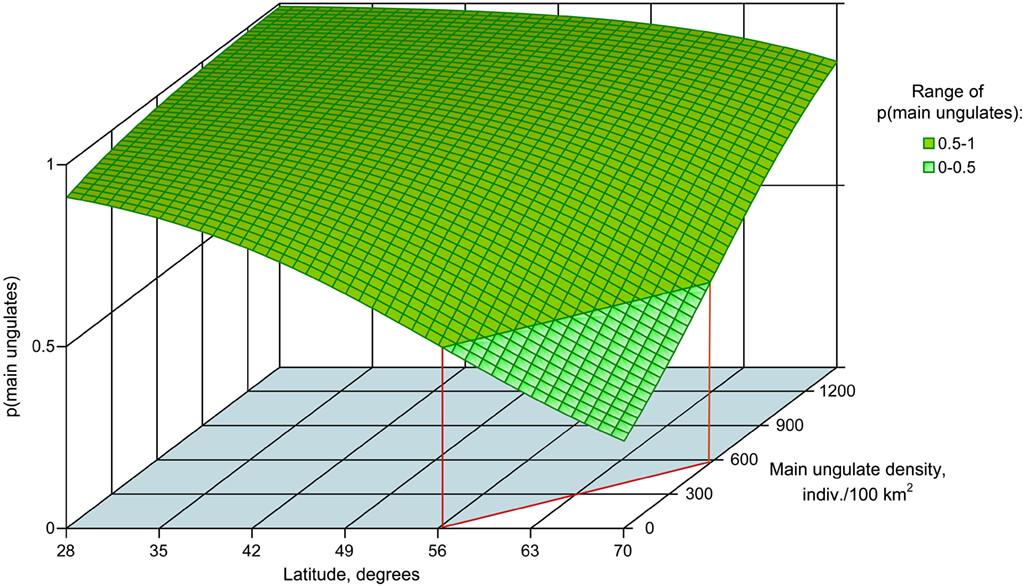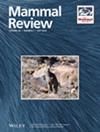Patterns of predation by the Eurasian lynx Lynx lynx throughout its range: ecological and conservation implications
IF 4.4
2区 生物学
Q1 ECOLOGY
引用次数: 1
Abstract
- Predation on ungulates exposes large predators to conflicts with farmers and hunters if they kill livestock and shared game species. Therefore, it is crucial to know the drivers of predation on large prey, understand how they differ from predation on smaller prey and reveal general large-scale patterns.
- We tested three hypotheses in the global Eurasian lynx Lynx lynx population: 1) consumption of ungulates and hares increases with their densities, 2) effects of predictors on ungulate and hare predation differ between continents, latitudes, longitudes and landscapes, 3) effects of predictors are generally applicable regardless of study materials (scats, carcasses and intestinal tracts).
- We collected information from 70 publications, including data from 174 study cases (107 from Europe and 67 from Asia) and 114 sites in 30 countries, mainly Russia (73 cases and 46 sites). Linear regression of logit-transformed data and logistic regression were used to test the hypotheses.
- We found that ungulates made up more than half of the lynx diet in areas containing at least 570 individual ungulates/100 km2 and/or located south of 56°N. Predominance of ungulates in the diet could be related to the higher availability of the main medium-sized ungulate prey species, and to the presence of (mixed) broadleaf deciduous forests with open spaces providing optimal hunting conditions. No significant effects on hare consumption by lynx were revealed, possibly because of a small sample size of hare density data from lynx habitats, fluctuations and instability of hares as a food resource, declines of some hare populations and separation in habitat use by lynx and hares.
- We conclude that the Eurasian lynx is an adaptable predator, not a lagomorph specialist; throughout its range, the lynx takes ungulates according to their availability. The use of practical nonlethal interventions is important to limit the availability of domestic ungulates (livestock and game) for predation by lynx, and to promote human-lynx coexistence.

欧亚山猫在其整个范围内的捕食模式:生态和保护影响
捕食有蹄类动物会使大型捕食者与农民和猎人发生冲突,如果他们杀死牲畜和共享的猎物物种。因此,了解捕食大型猎物的驱动因素,了解它们与捕食小型猎物的区别,并揭示一般的大规模模式是至关重要的。我们在全球欧亚猞猁种群中测试了三个假设:1)有蹄类动物和野兔的食用量随其密度的增加而增加;2)预测因子对有蹄类动物和野兔捕食的影响因大陆、纬度、经度和景观而异;3)无论研究材料(粪便、尸体和肠道)如何,预测因子的影响都普遍适用。我们收集了70份出版物的信息,包括174个研究案例(107个来自欧洲,67个来自亚洲)和30个国家114个地点的数据,主要是俄罗斯(73个病例和46个地点)。采用对数变换数据的线性回归和逻辑回归对假设进行检验。我们发现,在每100平方公里至少有570只有蹄类动物和/或位于56°N以南的地区,有蹄类动物占猞猁饮食的一半以上。有蹄类动物在饮食中的优势可能与主要中型有蹄类猎物种类的可得性较高有关,并且与(混合)阔叶落叶林的存在有关,开阔的空间提供了最佳的狩猎条件。结果显示,猞猁对野兔的消费没有显著影响,这可能是由于来自猞猁栖息地的野兔密度数据样本较小,野兔作为食物资源的波动和不稳定,一些野兔种群的减少以及猞猁和野兔对栖息地的使用分离。我们得出的结论是,欧亚猞猁是一种适应性强的捕食者,而不是lagomormorphspecialist;在整个活动范围内,猞猁根据它们的可用性来选择有蹄类动物。使用实际的非致命干预措施对于限制猞猁捕食家养有蹄类动物(牲畜和猎物)的可用性以及促进人类与猞猁的共存是很重要的。
本文章由计算机程序翻译,如有差异,请以英文原文为准。
求助全文
约1分钟内获得全文
求助全文
来源期刊

Mammal Review
生物-动物学
CiteScore
12.20
自引率
4.10%
发文量
29
审稿时长
>12 weeks
期刊介绍:
Mammal Review is the official scientific periodical of the Mammal Society, and covers all aspects of mammalian biology and ecology, including behavioural ecology, biogeography, conservation, ecology, ethology, evolution, genetics, human ecology, management, morphology, and taxonomy. We publish Reviews drawing together information from various sources in the public domain for a new synthesis or analysis of mammalian biology; Predictive Reviews using quantitative models to provide insights into mammalian biology; Perspectives presenting original views on any aspect of mammalian biology; Comments in response to papers published in Mammal Review; and Short Communications describing new findings or methods in mammalian biology.
 求助内容:
求助内容: 应助结果提醒方式:
应助结果提醒方式:


